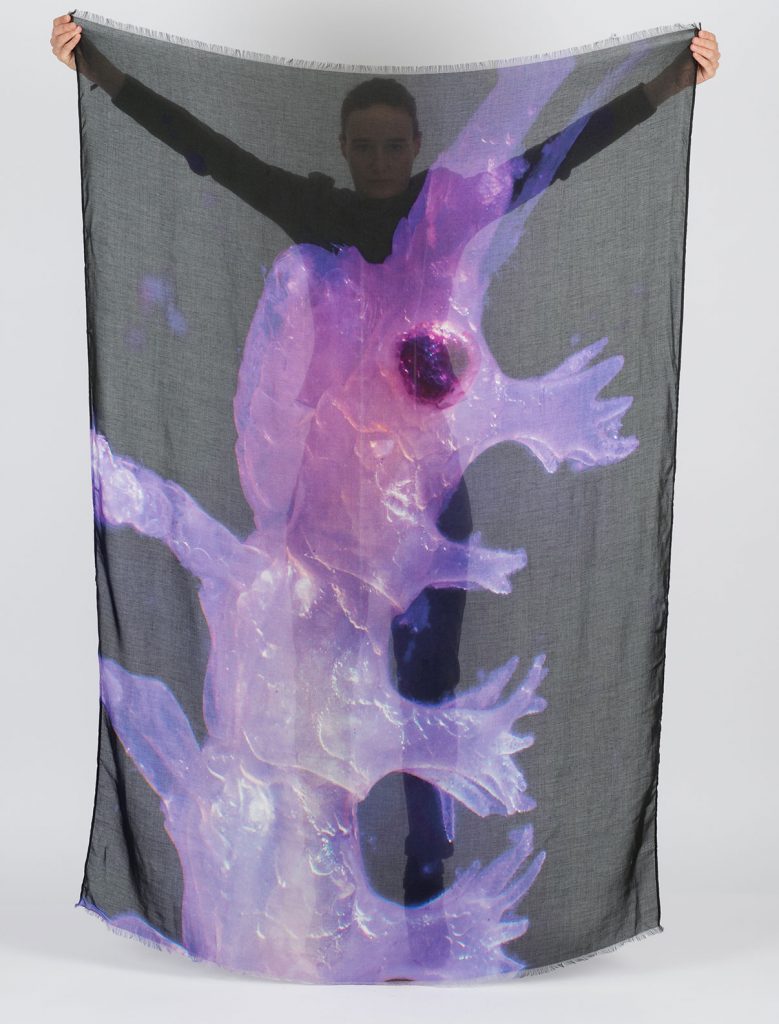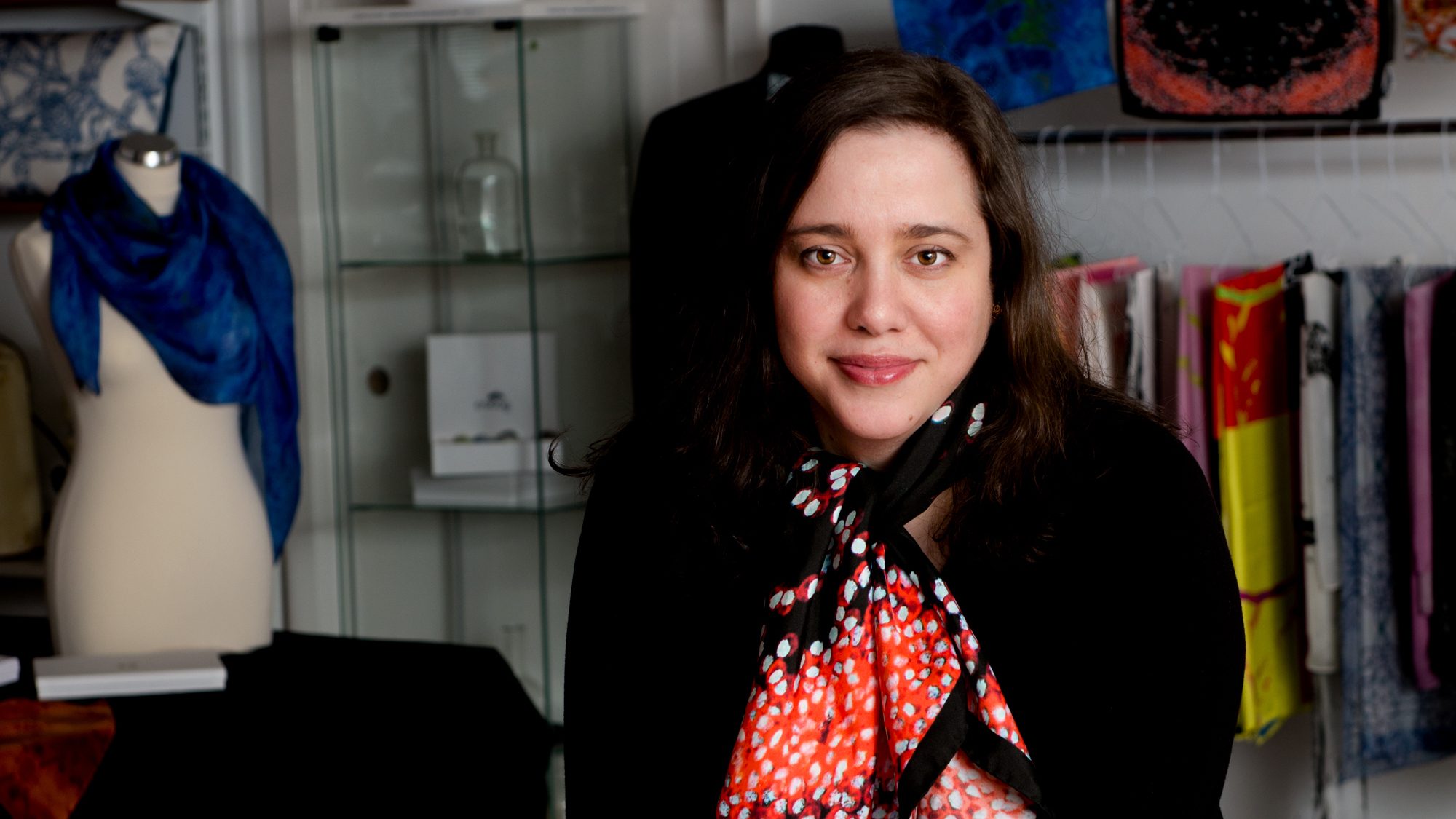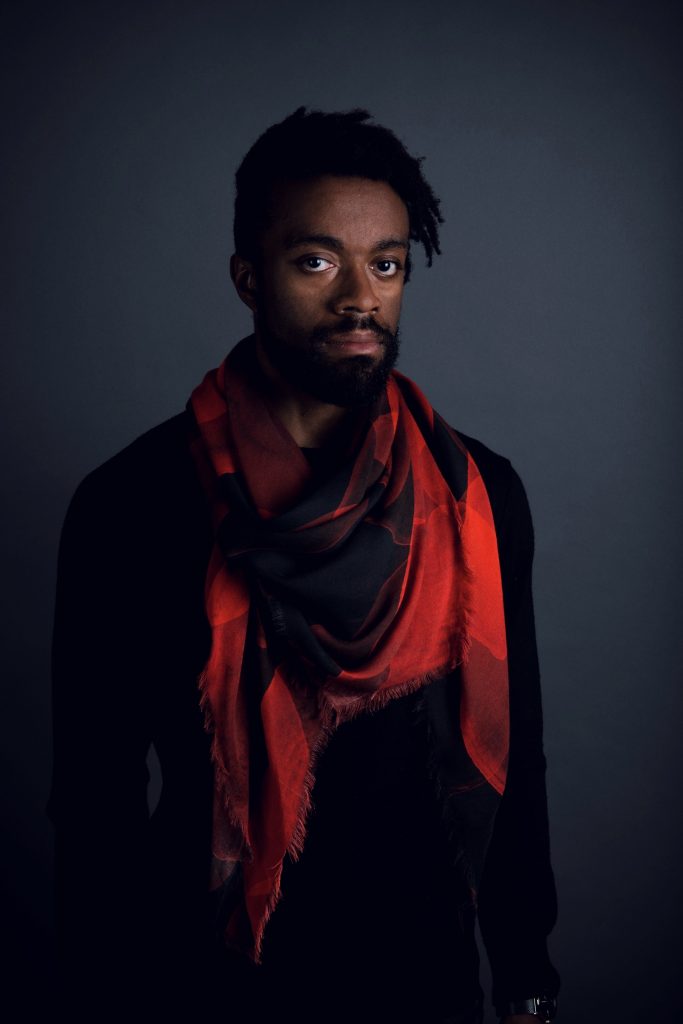How a deep passion for the sea turned a scientist into a fashion creative with an incredibly unique and desirable collection of scarves that reveal the unseen beauty of the ocean
Continuing our blog series on the designers we work with, we turn the Forest Digital spotlight on to Jessica Giannotti, the brains and designer behind Crùbag, a Scottish label producing fabulous scarf collections that highlight the wonders and mysteries of the ocean. How did Jessica, who hails from Venezuela and studied marine science, end up living on the west coast of Scotland designing scarves?
Background
Jessica was brought up in Caracas by her Venezualan mother and Italian father. As a child she spent holidays on stunning Caribbean beaches and remembers being fascinated by the sea – playing with crabs, lost in time and immersed in the environment. Though her true love was for the ocean, she began her working life as a showjumper and equestrian trainer. A riding accident that led to a long period of convalescence, coupled with a growing unease about the ethics of horse training, made Jessica seek a new direction. In Berlin, whilst working as a market researcher, she met Andreas who was studying Gaelic in Scotland – while visiting him she not only fell for Andreas – who became her husband – but also for the beautiful Argyll coast. Finally satisfying her childhood love of the sea, she embarked on a degree in the multidisciplinary course of Marine Science at the Scottish Association for Marine Science (SAMS).
Marine science combines marine biology, geology, chemistry and physical oceanography and sees the ocean as an interconnected system so Jessica studied differing aspects of the ocean, and sees it in an holistic way. Her main concerns for the future of the ocean – and the planet – focus on plastic pollution, climate change and deep-sea mining for oil and rare minerals.
Inspiration
Jessica’s mother is a mixed media artist who adds pearls and sands from the beach to create textured paintings so Jessica was exposed to art from an early age. Fashion-wise she loves the designs of McQueen and Iris van Herpen who’s clothes she sees as ‘living sculptures’. But Jessica never imagined she would become a creative herself, let alone a fashion designer, thinking instead that her career path lay in science.
However, while studying at SAMS, the phytoplankton and other small organisms that Jessica saw through her microscope and the library of science images she now had access to left her awestruck – ‘her inner child was always excited and looking forward to more’ and long before she graduated she started to see the design potential of the scientific images of marine life. The images visited her in her dreams, she would awaken and doodle them and eventually she felt like she ‘had no choice’ but to pursue her idea, even though she had no art or fashion training and knew nothing about textiles.
 She tried to work with other designers but then finally realised that she preferred her own creations and was brave enough to share her vision with a scientist friend (and her former lecturer) Dr Claire Gachon who was studying algae and pathogen interactions. Dr Gachon offered Jessica her support, and her library of research images, and they got funding for Jessica’s first collection. So Crùbag was born – it is Scottish Gaelic for crab and the logo was inspired by fiddler crabs from the Mangroves in Venezuela so combining both Scottish and Venezuelan heritages.
She tried to work with other designers but then finally realised that she preferred her own creations and was brave enough to share her vision with a scientist friend (and her former lecturer) Dr Claire Gachon who was studying algae and pathogen interactions. Dr Gachon offered Jessica her support, and her library of research images, and they got funding for Jessica’s first collection. So Crùbag was born – it is Scottish Gaelic for crab and the logo was inspired by fiddler crabs from the Mangroves in Venezuela so combining both Scottish and Venezuelan heritages.
Jessica worked and researched hard – training herself in digital and fashion design, taking courses in Photoshop, Illustrator and InDesign, seeking out mentors and those in the textile and fashion industry to learn as much as she could. She began with a large library of stunning algae and pathogen images from Dr Gachon…and learnt how to create patterns. When she showed them to Dr Gachon and saw how overcome she was, she knew she was on the right track and the first collection ‘Gachon’ came on the market in 2014.
Process
At Crùbag, every collection is a collaboration – a result of people coming together. Jessica does all the designs but works very closely with the scientists who share their images, discoveries and research and help develop the aesthetics of the collection. Jessica studies the scientist’s papers, works on mood boards to convey the essence of the scientific discoveries. She even works in a large light-filled studio that was where she once studied at SAMS. She forms strong relationships with the scientists and says it’s ‘like creating babies’.
The latest collection – Seamount – highlights the unique environments and strange species of deep-sea mountains, rarely visited mysterious and mind-blowing places that are only being explored now. Crùbag even revealed a newly discovered seamount species to the world via a scarf – the friendly and totally surreal looking arcturididae – before science had revealed the finding!

Crùbag has also collaborated with schools and football teams, always staying true to their ethos of revealing the wonders of marine science and our precious oceans.
Scarf Collections
Crùbag features three scarf collections….Gachon, Flora and Seamount.
Gachon has a brightly coloured palette and uses breathtaking microscopy images of Dr Claire Gachon’s research on the warfare between the brown marine algae Ectocarpus and the beautiful oomycete pathogen Eurychasma.
Flora is inspired by the smallest of algae and their harmful blooms. It’s about red tides and so much more. The unseen natural patterns reveal the edgy ocean and how algae can impact marine ecosystems and results in a light airy collection of four silk chiffon scarves.
Seamount is an intensely beautiful collection – dark, powerful and foreboding like the mountains of the sea that inspired it. A collection that introduces the wearer to an unknown world that marine scientists are only just discovering.
We asked Jessica why she chose Forest Digital to digitally print Crùbag’s scarves…
“I still have silk scarves from my childhood, gifted to me by my Italian grandmother when I was around 12. Scarves are an iconic fashion staple that are like canvases and are treasures that can last a lifetime so they have a minimum environmental impact. I still have those same scarves framed in my studio to remind me. We print on natural materials – silk, twill and cashmere modal. It’s obviously important they are sustainable. We focus on the diversification of resources, so we don’t apply pressure to the resource. The samples you get back from the different digital print companies vary so much even from the same file. We were very happy with the sample results that were returned from Forest Digital. The colours go through the cashmere modal and are so vibrant, really amazing. We were able to experiment and test to see which colours worked which was good. We think digital print is the best method – for environmental reasons and creative reasons. You don’t have to colour separate, you have the freedom of the colours. Our designs have depth, which we want to retain. That low-fi feeling. There’s a lot of work behind it, an intense process, but we have learnt so much over the years and we love it. We would love to experiment more with Forest Digital – the quality and the type of fabrics they use is high. Also Forest Digital are very approachable – we are a small brand and it can sometimes be hard to be taken seriously, but they were welcoming from the beginning”
The Future
Crùbag are “a small brand but we can be flexible and we can be an example. We can become a model for sustainability.” They are currently doing a review of the materials to get up to speed on what is available and they are opening a showroom at SAMS in September and hope to complement their scarf collections with activewear, more collaborations and expand their homewares.
We look forward to Crùbag’s future creations and wish Jessica every success. We know the planet, especially our precious oceans, are grateful too.
Crùbag digitally printed scarves come in silk twill, cashmere modal, and silk chiffon, in a variety of sizes and colours and cost from £65-£220. They are for sale through Crùbag’s website and 10% of the profits go to scientific institutions to support marine research.


